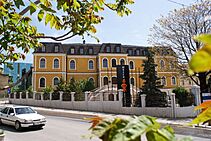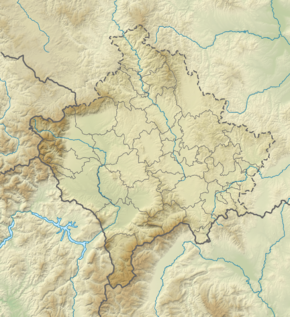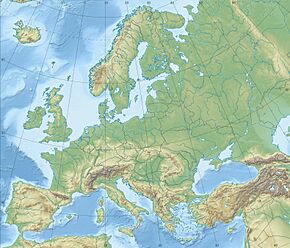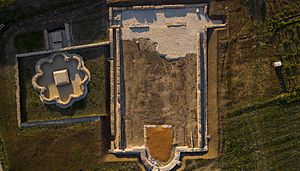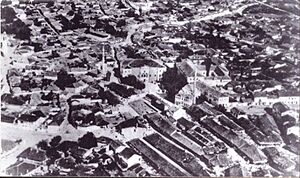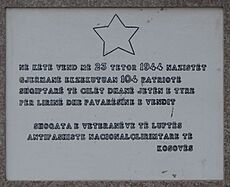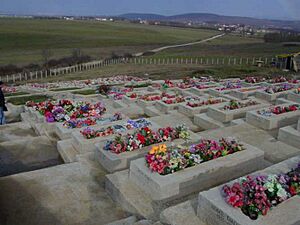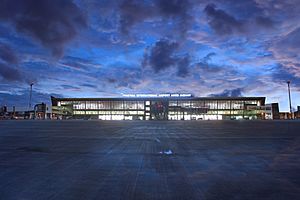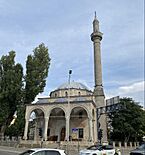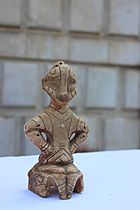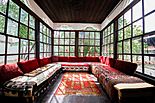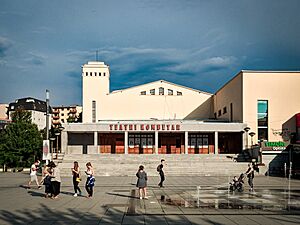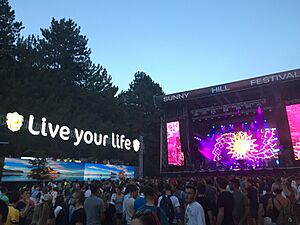Pristina facts for kids
Quick facts for kids
Pristina
Prishtina
|
|||
|---|---|---|---|
|
Capital city and municipality
|
|||
|
View of Pristina
Goddess on the Throne
Newborn Monument
Kosovo Museum
Clock Tower
Great Hamam and Imperial Mosque
Skanderbeg Monument
|
|||
|
|||
| Country | Kosovo | ||
| Municipality | Pristina | ||
| Government | |||
| • Type | Mayor–council | ||
| Area | |||
| • Municipality | 523.13 km2 (201.98 sq mi) | ||
| Area rank | 6th in Kosovo | ||
| Elevation | 652 m (2,139 ft) | ||
| Population
(2024)
|
|||
| • Municipality | 227,154 | ||
| • Rank | 1st in Kosovo | ||
| • Density | 434.221/km2 (1,124.627/sq mi) | ||
| • Ethnicity |
|
||
| Demonym(s) | Albanian: Prishtinas (m), Prishtinase (f) Gheg Albanian: Prishtinali (m), Prishtinalike (f) |
||
| Time zone | UTC+1 (CET) | ||
| • Summer (DST) | UTC+2 (CEST) | ||
| Postal code |
10000
|
||
| Area code | +383 (0) 38 | ||
| Vehicle registration | 01 | ||
| Motorways | |||
| Major airport | Adem Jashari Airport | ||
Pristina (pronounced PREE-shtin-uh) is the capital and largest city of Kosovo. It is the main center for the city and the surrounding area.
Long ago, the Pristina area was part of the Dardanian Kingdom. An ancient settlement called Ulpiana shows its classical history. After the Roman Empire split, the area was part of the Byzantine Empire for centuries. It later became part of the First Bulgarian Empire and then the Second Bulgarian Empire. In the 13th century, the Kingdom of Serbia took over, followed by the Serbian Empire in the 14th century.
From the late 14th century, the Ottoman Empire ruled Pristina. During this time, Pristina grew from a small village into an important city. After the First Balkan War in 1914, it became part of the new Kingdom of Serbia. In 1948, Pristina was chosen as the capital of SAP Kosovo within Yugoslavia. It has remained the capital of Kosovo since its independence in 2008.
Pristina was a small village before the late 1400s. It was first mentioned in 1342 and had about 300 homes in 1455. In the next century, Pristina became a key mining and trading hub. This was because it was close to the rich mining town of Novo Brdo. The city was known for its trade fairs and goods like goatskin and gunpowder.
Today, Pristina is the main economic, financial, political, and trade center of Kosovo. This is due to its central location. It is where the Government of Kosovo works, and where the President and Prime Minister of Kosovo have their offices. The Parliament of Kosovo is also here. Pristina is also Kosovo's most important hub for air, rail, and road travel. Pristina International Airport is the country's largest airport. Major roads like the R 6 and R 7 connect Pristina to Albania and North Macedonia. Pristina will even host the 2030 Mediterranean Games.
Contents
What's in a Name?
The exact origin of Pristina's name is not fully known. Some experts think it comes from old words meaning "ford-stone." This would describe a place where you could cross a river near stones.
Another idea is that the name comes from a Slavic word meaning "boil," possibly referring to bubbling water from a nearby river. Some also suggest it comes from a Slavic personal name. Another theory links it to a Proto-Slavic word for "spring of water."
Most people who live in Pristina are Albanians. They call themselves Prishtinali in their local language.
A Look Back at Pristina's Past
Early Beginnings
People have lived in the Pristina area since the Stone Age, around 7,000 BCE. The oldest signs of life were found in Gračanica, Matiçan, and Ulpiana.
Around the early Iron Age, a unique local culture appeared in Kosovo. In the Pristina area, a settlement was found on a hilltop from the 8th century BCE. This shows that people lived there and traded with distant places.
In the 4th century BC, the Dardanian Kingdom was formed in this region. Ulpiana became an important Roman city and a major center in the 2nd century BC. In the mid-9th century, it became part of the First Bulgarian Empire.
From the 11th to 16th Centuries

In the early 11th century, Pristina came under Byzantine rule. It was later part of the Second Bulgarian Empire multiple times.
In 1315, the nearby Gračanica monastery was built. Pristina was first mentioned by name in historical records between 1315 and 1318. A Byzantine Emperor described it as an "unfortified village" a few years later. During the Kingdom of Serbia in the early 14th century, a main trade route passed through Pristina.
Between the late 14th and mid-15th centuries, the Ottoman Empire slowly took control. In 1477, Pristina had a small Muslim population. At that time, about three-quarters of the households were Christian and one-quarter were Muslim. By the 16th century, more than half of the population had Muslim names.
From the 17th to 20th Centuries
During a war between Austria and the Ottoman Empire in the late 1600s, some citizens of Pristina supported the Austrian army. They even provided 6,000 Albanian soldiers. Sources from the 17th century describe Pristina as being in "Albania."
In the 18th century, Pristina rebuilt its buildings and infrastructure. It became known for the local Gjinolli family who governed the area.
In 1901, Albanians looted and burned parts of Pristina. Later, in 1912, Serb forces took Pristina. However, Bulgaria occupied Kosovo in 1915 and took control of Pristina.
During the Balkan Wars, Pristina faced many challenges. The Serbian army entered Pristina in October 1912. Homes were looted, and people were killed. A journalist reported that the Serbian actions were like a "horrific massacring of the Albanian population." About 5,000 people in Pristina were killed. Serbian settlers were brought into the city.
In late 1918, French forces took over Pristina and returned it to what became Yugoslavia. From 1929 to 1941, Pristina was part of the Kingdom of Yugoslavia.
In 1941, Yugoslavia surrendered to Axis forces. A "Greater Albania" was declared, with most of Kosovo under Italian control. After Italy surrendered, Nazi Germany took control. In May 1944, 281 local Jewish people were arrested and sent to Germany, where many were killed.

After World War II, Pristina became the capital of Kosovo. The University of Pristina was founded, boosting Albanian-language education. Albanians were also allowed to use their flag.
Kosovo War and Aftermath
In 1989, Kosovo's self-rule was reduced. A strict government was put in place, and many Albanians lost their jobs in state companies. When the Kosovo Liberation Army began fighting in 1996, Pristina remained mostly calm until the Kosovo War started in March 1999.
Pristina did not suffer as much damage as some other towns. However, some military targets were hit during NATO's air campaign. These included the post office, police headquarters, and army barracks.
During the war, there was violence in Pristina. Forces shelled areas and forced many ethnic Albanians to leave their homes. Many were put on trains and sent to the border of Macedonia.
Most of the Albanian population left Pristina to escape the violence. When NATO troops entered in June 1999, Russian troops arrived at the airport first. After the war, Serbs faced violence from some Kosovo Albanian extremists. Many Serbs fled Kosovo, and today only a few dozen remain in the city.
Pristina in the 21st Century
The new terminal at Pristina International Airport opened in 2013, due to more people traveling by air. In the same year, the R7 motorway was finished. This road connects Pristina to the Albanian city of Durrës on the coast. Another big development was the completion of the R6 motorway in 2019. This road links Pristina to Skopje, the capital of North Macedonia.
Pristina's Location and Environment
Pristina is located on a flat plain in central and eastern Kosovo. The city has lakes like Badovc and Batllava, and rivers like Llapi and Prishtevka. Germia Park is a large green area to the east of Pristina.
Pristina sometimes has water shortages, especially when there isn't enough rain or snow. The city gets its water from Batllava Lake and Lake Badovc. Authorities are working to improve the water supply so these problems don't happen again.
Pristina's Climate
Pristina has a moderate climate. The average yearly temperature is about 10.6 degrees Celsius (51 degrees Fahrenheit). August is the warmest month, with temperatures around 21.8 degrees Celsius (71 degrees Fahrenheit). January is the coldest, with temperatures around -0.6 degrees Celsius (31 degrees Fahrenheit).
Pristina gets a good amount of sunshine, with about 2900 hours per year. July is the sunniest month, while January has the least sunshine.
| Month | Jan | Feb | Mar | Apr | May | Jun | Jul | Aug | Sep | Oct | Nov | Dec | Year |
|---|---|---|---|---|---|---|---|---|---|---|---|---|---|
| Record high °C (°F) | 15.8 (60.4) |
20.2 (68.4) |
26.0 (78.8) |
29.0 (84.2) |
32.3 (90.1) |
36.3 (97.3) |
39.2 (102.6) |
36.8 (98.2) |
34.4 (93.9) |
29.3 (84.7) |
22.0 (71.6) |
15.6 (60.1) |
39.2 (102.6) |
| Mean daily maximum °C (°F) | 2.4 (36.3) |
5.5 (41.9) |
10.5 (50.9) |
15.7 (60.3) |
20.7 (69.3) |
23.9 (75.0) |
26.4 (79.5) |
26.7 (80.1) |
23.1 (73.6) |
17.1 (62.8) |
10.1 (50.2) |
4.1 (39.4) |
15.5 (59.9) |
| Daily mean °C (°F) | −1.3 (29.7) |
1.1 (34.0) |
5.0 (41.0) |
9.9 (49.8) |
14.7 (58.5) |
17.8 (64.0) |
19.7 (67.5) |
19.5 (67.1) |
15.9 (60.6) |
10.6 (51.1) |
5.1 (41.2) |
0.4 (32.7) |
9.8 (49.6) |
| Mean daily minimum °C (°F) | −4.9 (23.2) |
−2.8 (27.0) |
0.2 (32.4) |
4.2 (39.6) |
8.5 (47.3) |
11.4 (52.5) |
12.5 (54.5) |
12.3 (54.1) |
9.4 (48.9) |
5.0 (41.0) |
0.9 (33.6) |
−3.1 (26.4) |
4.4 (39.9) |
| Record low °C (°F) | −27.2 (−17.0) |
−24.5 (−12.1) |
−14.2 (6.4) |
−5.3 (22.5) |
−1.8 (28.8) |
0.5 (32.9) |
3.9 (39.0) |
4.4 (39.9) |
−4.0 (24.8) |
−8.0 (17.6) |
−17.6 (0.3) |
−20.6 (−5.1) |
−27.2 (−17.0) |
| Average precipitation mm (inches) | 38.9 (1.53) |
36.1 (1.42) |
38.8 (1.53) |
48.8 (1.92) |
68.2 (2.69) |
60.3 (2.37) |
51.6 (2.03) |
44.0 (1.73) |
42.1 (1.66) |
45.4 (1.79) |
68.2 (2.69) |
55.5 (2.19) |
597.9 (23.54) |
| Average precipitation days (≥ 0.1 mm) | 13.6 | 12.3 | 11.4 | 12.1 | 12.8 | 11.9 | 8.3 | 7.9 | 7.5 | 8.6 | 12.3 | 14.5 | 133.2 |
| Average snowy days | 10.2 | 8.3 | 6.2 | 1.5 | 0.0 | 0.0 | 0.0 | 0.0 | 0.0 | 0.5 | 3.4 | 8.1 | 38.2 |
| Average relative humidity (%) | 83 | 77 | 70 | 65 | 67 | 67 | 63 | 62 | 68 | 74 | 80 | 83 | 71 |
| Mean monthly sunshine hours | 70.8 | 96.0 | 143.0 | 184.0 | 227.9 | 246.3 | 299.3 | 289.6 | 225.8 | 173.5 | 96.9 | 70.2 | 2,123.3 |
| Source: Republic Hydrometeorological Service of Serbia | |||||||||||||
Pristina's Economy and Tourism
Pristina is the heart of Kosovo's economy. The service industry, like shops and offices, is the most important. It employs over 75% of the city's workers. Manufacturing and construction employ 20%, and farming only 5%.
Pristina is the main place for tourists in Kosovo. It's also the main airport gateway to the country. Many students from nearby countries like Albania and North Macedonia come here for university. In 2012, about 100,000 foreign visitors came to Pristina. Most tourists are from Albania, Turkey, Germany, and the United States.
The city has many fancy hotels, modern restaurants, and cafes. Coffee bars are very popular and can be found almost everywhere. The biggest hotels are the Swiss Diamond and the Grand Hotel Pristina.
Some popular places to visit near the city include Batllava Lake and Marble Cave. Pristina also helped Jewish people during World War II, and their cemeteries can be visited today. There is also a bear sanctuary about 22 km (14 miles) from Pristina, which is a fun place for tourists.
Getting Around Pristina
Pristina is Kosovo's main center for transportation. It has modern infrastructure and is located in the middle of the country. Since Kosovo became independent, the city has greatly improved its economy and transport links.
Pristina is the most important road hub in Kosovo. All major expressways and motorways pass through or near the city. Once finished, the R6 motorway will connect Pristina directly to Skopje. The R7 motorway already links Pristina to Durrës in Albania.
Pristina International Airport is the main airport for Kosovo. It handles almost 2 million passengers each year. You can fly from Pristina to many cities in Europe, especially in Austria, Germany, Switzerland, and the United Kingdom.
Pristina is also a hub for trains. The Pristina railway station is near the city center. There's also the Fushë Kosovë railway station, which is Kosovo's main railway hub. A train travels daily from Pristina to Skopje.
Learning in Pristina

Pristina is the main center for education in Kosovo. It has many public and private schools, colleges, and universities. The University of Pristina is the largest and oldest university in the city. It was founded in the 20th century.
Many young students from other cities and countries come to Pristina to study. Popular subjects include finance, arts, journalism, medicine, and engineering. The city is known for its many educational places like the University of Pristina and the Academy of Sciences and Arts of Kosovo.
Some of the first schools in the city were opened during the Ottoman period. Albanians could attend these schools, which were mostly religious.
The city has many libraries with huge collections of historical and cultural documents. The most important is the National Library of Kosovo, which has over 1.8 million books and other materials.
Pristina's People
| Population history of the municipality of Pristina | ||
|---|---|---|
| Year | Pop. | ±% |
| 1948 | 44,089 | — |
| 1953 | 51,457 | +16.7% |
| 1961 | 69,810 | +35.7% |
| 1971 | 105,273 | +50.8% |
| 1981 | 148,656 | +41.2% |
| 1991 | 199,654 | +34.3% |
| 2011 | 198,897 | −0.4% |
| 2024 | 227,154 | +14.2% |
In 2024, Pristina had 227,154 residents. This makes it the most populated city and municipality in Kosovo.
In the 2011 census, there were 198,897 people living in Pristina. About 160,000 lived in the city, and 37,000 lived in rural areas. Pristina is the third most crowded municipality in Kosovo.
The population of Pristina grew by 14.2% between 2011 and 2024. This shows how fast the city and Kosovo are growing.
Who Lives in Pristina?
Most people in Pristina are Albanian (97.77%). Other groups include Turkish (1.08%), Ashkali (0.28%), and Serbian (0.22%).
Most people (98.09%) speak Albanian as their first language. Other languages spoken include Turkish (1.04%) and Serbian (0.25%).
Faith and Beliefs
Most people in Pristina are Muslims (97.27%). There are also Roman Catholics (0.59%) and Orthodox Christians (0.24%). Kosovo is a country where people are free to choose their own religion. The freedom of belief is guaranteed in the Constitution of Kosovo. While Islam is the most common religion, Pristina has places of worship for many different faiths.
Pristina's Culture
Pristina is home to Kosovo's biggest cultural places. These include the National Theatre of Kosovo, the National Archaeology, Ethnography and Natural Science Museum, and the National Art Gallery. The National Library of Kosovo has over 1.8 million books.
Many foreign cultural groups also have offices in Pristina. These include the French Alliance Française, the British Council, and the German Goethe-Institut.
Out of 426 protected historical buildings in Kosovo, 21 are in Pristina. Many of these are from the Byzantine and Ottoman times.
After 1945, the Yugoslav government started building a modern Pristina. This led to big changes in the city's buildings and how they were used.
However, many old buildings have been saved. These include four mosques, a restored Orthodox church, an Ottoman bath, a public fountain, a clock tower, and traditional houses. These show Pristina's long history under different empires.
The Mbretëresha e Dardanisë (Queen of Dardania) or Hyjnesha ne Fron (The Goddess on the Throne) is an ancient clay statue. It was found near Pristina in 1955 and dates back to 3500 BC. Pristina also has the "Hamami i Qytetit" (The City Bath) and the house of Emin Gjika, which is now the Ethnographic Museum.
Media in Pristina
Pristina is the main center for media in Kosovo. Most major news organizations, publishing houses, and TV studios are based here. The television industry is a big employer in the city. The four main TV networks, RTK, RTV21, KTV, and KLAN KOSOVA, are all in Pristina.
Radio Television of Kosovo (RTK) is the only public broadcaster in Kosovo. All daily newspapers in Pristina are read throughout Kosovo. Since 2005, the University of Pristina has had a Journalism Faculty, where many young people study.
Music Scene
Albanian music is very rich and has many different styles. The folklore of Kosovo is especially important. It is seen as a cultural treasure and helps us understand Albanian history. Folklore has also inspired many musicians, like Rexho Mulliqi.
Music from Kosovo and Albania share many natural similarities, even though they developed in different ways. This shows they come from the same "Cultural Tree."
Some famous international music artists with Albanian roots who were born in Pristina or whose families are from there include Rita Ora, Dua Lipa, and Era Istrefi.
Theater Performances
Pristina has three active theaters: the National Theater, Oda, and Dodona Theatre. They offer live shows every week. The National Theater was founded in 1946 and is the highest-ranked theater in the country. It has put on over 400 shows for more than 3 million people.
Exciting Festivals
The Sunny Hill Festival happens every year in Pristina. It's the biggest festival in Kosovo and brings over 100,000 music fans from all over the world. Famous artists like Dua Lipa, Miley Cyrus, and J Balvin have performed there.
The Prishtina International Film Festival shows important international movies. It also highlights the film industry in Kosovo. This festival started after Kosovo became independent in 2008.
Other major festivals include the Chopin Piano Fest Pristina. It started in 2010 to celebrate the 200th birthday of Frédéric Chopin. This festival promotes piano music and has featured world-famous pianists.
The DAM Festival Pristina is another important cultural event. It's a yearly music festival that brings together young musicians from around the world. It mixes traditional and modern music.
Sports in Pristina
Pristina is the center of sport in Kosovo. Sports are organized by the Kosovo Olympic Committee. There are seven Municipal Leagues in Pristina for different sports.
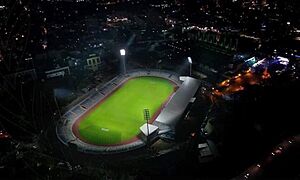
Football is the most popular sport. The main team is FC Prishtina, which plays at the Fadil Vokrri Stadium. Basketball is also very popular. KB Prishtina is the most successful basketball club in Kosovo.
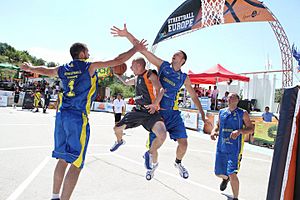
Streetball has been a popular event at Germia Park since 2000. Handball is also very popular, and Pristina's teams play international matches.
In September 2023, Pristina was chosen to host the 2030 Mediterranean Games.
International Connections
Pristina is a founding member of the Union of Albanian Municipalities in the Region.
Pristina is twinned with these cities:
Pristina also has a partnership agreement with Zagreb.
See also
 In Spanish: Pristina para niños
In Spanish: Pristina para niños





